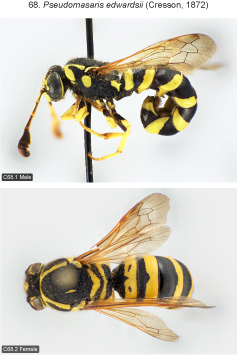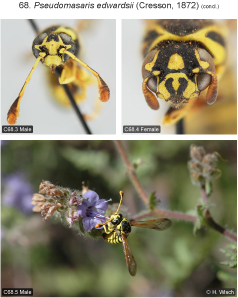
| Home | Table of contents | Keys | Species list | Glossary | Image data | PDF | Cite this article | Feedback | Updates |
Identification Atlas of the Vespidae (Hymenoptera, Aculeata) of the northeastern Nearctic region
CJAI 05, February 19, 2008
doi: 10.3752/cjai.2008.05
Matthias Buck, Stephen A. Marshall, and David K.B. Cheung
Department of Environmental Biology, University of Guelph, Guelph, Ontario, Canada N1G 2W1
68. Pseudomasaris edwardsii (Cresson, 1872)
Figs B1.16; C68.1–5.

|

|
Species recognition (after Richards 1966). The female can be distinguished from other species in the genus by the following combination of characters: frons simple above antennal sockets (with sharp transverse ridge in other spp.), mid femur flattened beneath (rounded in other spp.), mid tibia almost always with a distinct anterior prominence near middle. The male is diagnosed as follows: fore basitarsus without posterior fringe, flagellomeres 4–5 wider than the antennal club (narrower in other spp.).
Variation. Fore wing length ca. 8.5 mm (both sexes). Variation otherwise not studied.
Distribution. Western U.S.: WA to CA, east to ID, WY, CO, UT and AZ. Mexico: Baja California Norte (Carpenter 2001). The single occurrence at Forks of the Credit in southern Ontario (6 ♂♂ from a malaise trap; PYU, AMNH) is clearly adventitious. Apparently, the species has not become established.
Biology. Mud nests consist of 1–10 cells attached to rocks or vegetation. Provisions with pollen and nectar from plants of ten genera of Hydrophyllaceae, Rhamnaceae, Tamaricaceae, Onagraceae, Lamiaceae, Boraginaceae, Caprifoliaceae, Asteraceae (Krombein 1979, Torchio 1970).
| Home | Table of contents | Keys | Species list | Glossary | Image data | PDF | Cite this article | Feedback | Updates |
